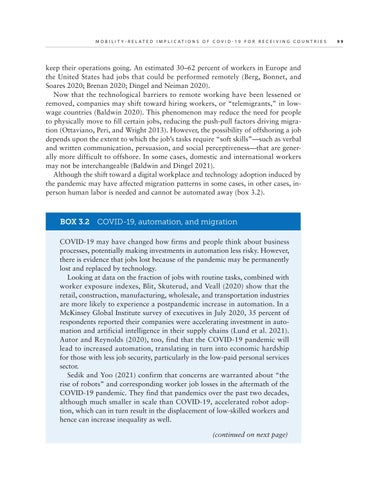M o b i l i t y - R e l a t e d I m p l i ca t i o n s o f C OVID - 1 9 f o r R e c e i v i n g C o u n t r i e s
keep their operations going. An estimated 30–62 percent of workers in Europe and the United States had jobs that could be performed remotely (Berg, Bonnet, and Soares 2020; Brenan 2020; Dingel and Neiman 2020). Now that the technological barriers to remote working have been lessened or removed, companies may shift toward hiring workers, or “telemigrants,” in lowwage countries (Baldwin 2020). This phenomenon may reduce the need for people to physically move to fill certain jobs, reducing the push-pull factors driving migration (Ottaviano, Peri, and Wright 2013). However, the possibility of offshoring a job depends upon the extent to which the job’s tasks require “soft skills”—such as verbal and written communication, persuasion, and social perceptiveness—that are generally more difficult to offshore. In some cases, domestic and international workers may not be interchangeable (Baldwin and Dingel 2021). Although the shift toward a digital workplace and technology adoption induced by the pandemic may have affected migration patterns in some cases, in other cases, inperson human labor is needed and cannot be automated away (box 3.2).
BOX 3.2 COVID-19, automation, and migration COVID-19 may have changed how firms and people think about business processes, potentially making investments in automation less risky. However, there is evidence that jobs lost because of the pandemic may be permanently lost and replaced by technology. Looking at data on the fraction of jobs with routine tasks, combined with worker exposure indexes, Blit, Skuterud, and Veall (2020) show that the retail, construction, manufacturing, wholesale, and transportation industries are more likely to experience a postpandemic increase in automation. In a McKinsey Global Institute survey of executives in July 2020, 35 percent of respondents reported their companies were accelerating investment in automation and artificial intelligence in their supply chains (Lund et al. 2021). Autor and Reynolds (2020), too, find that the COVID-19 pandemic will lead to increased automation, translating in turn into economic hardship for those with less job security, particularly in the low-paid personal services sector. Sedik and Yoo (2021) confirm that concerns are warranted about “the rise of robots” and corresponding worker job losses in the aftermath of the COVID-19 pandemic. They find that pandemics over the past two decades, although much smaller in scale than COVID-19, accelerated robot adoption, which can in turn result in the displacement of low-skilled workers and hence can increase inequality as well. (continued on next page)
9 9

